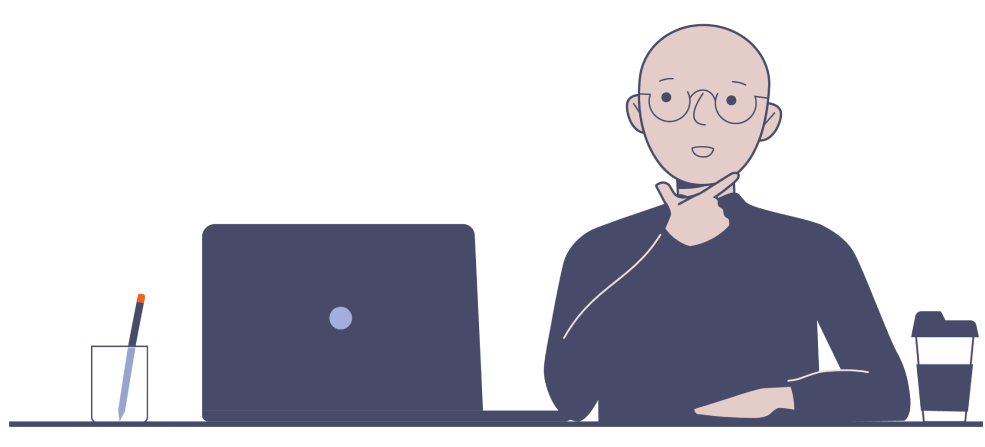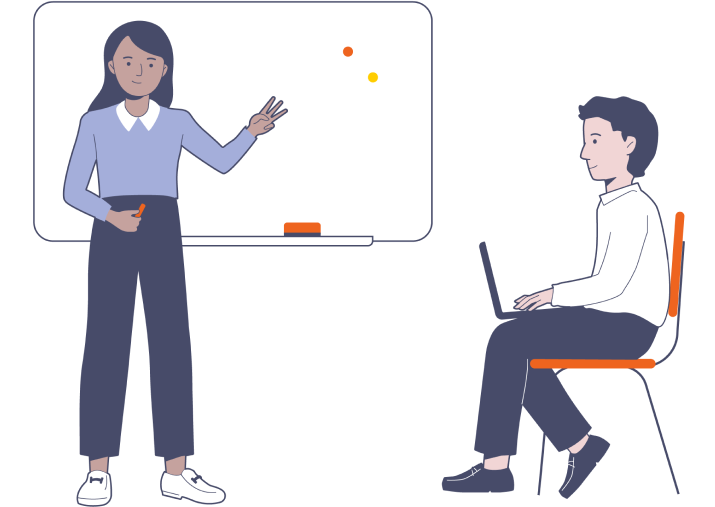
Responsive Coaching In Action
Resources|14th March 2021

Co-Founder & CEO — Steplab
How can we use Instructional Coaching to transform teacher quality when we don't agree about what it is and who it's for?
How can we use Instructional Coaching to transform teacher quality when we don't agree about what it is and who it's for? This series is about redefining what we talk about when we talk about Instructional Coaching.
This is the final part in the series.
- 1.
- 2.
- 3.
- 4.Part 4 Responsive Coaching in Action
Part 4: Responsive Coaching in Action
Kate – a new teaching and learning lead – has been on a journey to try to understand what Instructional Coaching is and how it works so that she can develop a powerful Instructional Coaching programme in her school.
In Part 1, she looked carefully at the three predominant definitions for Instructional Coaching, finding that none of them solved the problem of developing a programme that works for everyone.
She explores her thinking about the need for a coaching model that adapts to teacher expertise in Part 2.
In Part 3, she outlined a new model of Instructional Coaching that is responsive to teacher development needs and teacher expertise level.
Kate needs to get testing. In this post, she analyses two coaching conversations with teachers at either ends of the novice - expert spectrum at classroom management. She aims to get closer to an idea of exactly how responsive coaching could work. ___
Coaching a relative novice
Kyle is a first year trainee teacher. He is struggling with students talking during the DO NOW (first ten minutes of silent work) section of his lesson.
Kate: Last week we looked at greeting students at the door to help manage behaviour on the way into the classroom. I think you nailed it; it was effective when you reminded key students of the expectations. What was the impact on the start of your lesson?
Kyle: I was really pleased. I felt like I was in control of students entering the room for the first time.
Kate: It felt so much more controlled because you made your expectations really clear. Good job! Okay, let's keep talking about perfecting the first ten minutes. Did students meet your expectations throughout?
Kyle: Mostly, they were fine I think. There might have been a couple who were chatting. I’m not quite sure who it was.
Kate: You're right, there was a bit of chatting. I saw John talking throughout. Why is it important to do spot this and address it?
Kyle: Others will see him chatting and feel like this means they can as well?
Kate: Exactly. What can we do about this?
Kyle: I find it really difficult to challenge this sort of behaviour.
Kate: After all the great work you did on making expectations clear it’s important to follow through on what you expect: students may need a sanction at this point. At the same time, you need to do this in a way that avoids too much emotion. It’d be easy to discourage John from working for the rest of the lesson. I’ll show you this could look:
Action Step and Model: When a student talks during the DO NOW, move over to them and crouch down by their table. Issue a demerit using the following structure: Name, tag behaviour, name sanction, reset student, "John, you were talking during the DO NOW which is a silent part of the lesson so that we maximise our learning time. That will be a demerit. You did some great writing yesterday, so pen to paper and keep going with it.”
Why is it important to reset students after giving a demerit?
Kyle: So that they can see I'm not actually angry with them.
Kate: Right: you are making it about their learning, not about them personally. What did you notice about my tone and facial expression?
Kyle: Your tone was quite neutral, but you injected quite a bit of warmth into your voice during the last part.
Kate: Yes, I think that's important. You're not cross, you just expect students to meet your expectations You show him a way back. Right, okay, your turn. I want you to script your own version of the action step.
[Kyle scripts, and they read the script together.]
Kate: Let’s practice that. I'm going to be John. It's the DO NOW of your lesson. I want you to stand front right and scan. I'm going to cue you by talking, and then you come and issue the demerit to me. Action!
[Kyle reads his script. Kate thinks he needs to work on a neutral tone.]
Kate: Your script was really clear and efficiently worded. I knew exactly what was happening. Next time, try to neutralise your tone. You came across a bit cross. Something like this [model].
[Kyle reads his script. Kate thinks he needs to add an even warmer tone at the end.]
Kate: Your neutral tone was really effective: it didn't feel at all emotional or personal. This time, inject some warmth when you do your reset, like this [model].
[Kyle does it perfectly]
Kate: That was great Kyle! Let's go around again and lock it in. [They repeat practice many, many, many more times]. ___
Analysis of Diagnosis and Mechanism
In the last post, Kate made a distinction between diagnostic questions (D) used to determine expertise and the** operative mechanisms (M)** employed to cause learning. She decides to analyse the feedback along these lines.
“I think you nailed it; it was effective when you reminded key students of the expectations. What was the impact on the start of your lesson?” (D)
Kate checks that Kyle understood the impact of the positive changes. She summarises with a precise, 'sticky', clear explanation that clarifies: "It felt so much more controlled, because you made your expectations really clear.” ** (M)** Julie Cohen argues that this clarification is important so that teachers "...understand the positive contributions of their existing practice to the broader classroom environment..." (2020).
“Did students meet your expectations throughout?”** (D)**
Kate checks that Kyle has accurate ‘situation awareness’ (Endsley, 2006) of the events during the salient moments of his lesson.* “Mostly, they were fine I think. I think there might have been a couple who were chatting. I’m not quite sure who it was.”* This seems vague so Kate decides that provide some explanation to build his model of the event: "You're right, there was a bit of chatting. I saw John talking throughout." ** (M)**
"Why is it important to do catch this and address it?"** (D)**
Kate wants to check that Kyle understands the overall purpose of making a change. Kyle seems clear on this: "I guess others will see him chatting and feel like this means they can as well?"
"So what can we do about this?" (D)
Kate thinks of this moment as the time where she makes the key decision about how directive she will make the conversation. If Kyle had a clear mental model of an appropriate strategy, Kate doesn’t need to supply one. On the other hand, Kate knows that presenting this as a ‘problem’ to solve is likely to limit Kyle’s learning.
Because Kyle doesn’t seem to have the required mental models (“I find it really difficult to challenge this sort of behaviour.”), Kate sets a precise, manageable learning goal that she models. (M)
"Why is it important to reset students after giving a demerit?" (D)
Kate checks that Kyle has insight about behaviour management and motivation. He does ("So that they can see I'm not really angry!") so Kate feels she doesn’t need to explain further.
"And what did you notice about my tone and facial expression?"** (D)**
Kate checks that Kyle has a clear and accurate mental model of the ‘active ingredients’ of the strategy. He does, although Kate instinctively does some work to reinforce this: "You're not cross, you just expect students to meet your expectations You show him a way back.” ** (M)**
"I want you to script your own version of the action step..." (M)
Some form of scripting or planning is an important first stage in deliberate practice. They work to create an accurate script, where Kyle is supported through some of the hard thinking required.
"I'm going to cue you by talking, and then you come and issue the demerit to me. Action!”** (M)**
Kate specifically mentions the moment in the lesson where Kyle's change should be ‘triggered’. This helps to build situation awareness around using the strategy. Kyle practices the strategy, helping to build effective habits.
“Your script was really clear and efficiently worded. I knew exactly what was happening. Next time, try to neutralise your tone. You came across a bit cross. Something like this [model].”** (M)**
Kate asks Kyle to practice the change, gives specific feedback to improve performance, and models the change.
"Nailed it! Let's go round again and lock it in!" (M)
Kate points out the moment where Kyle is successful. She then asks him to repeat practise multiple times to help build habit strength. ___
Overall thoughts
"…instructional designs and instructional recommendations that require learners to engage in complex reasoning processes involving combinations of unfamiliar elements are likely to be deficient." (Merrienboer, J. G. Paas, F. 1998).
- 1.Kate employs diagnostic questions in the first section of feedback to allow her to match her mechanisms as closely as possible to Kyle’s expertise level. She recognises that this never going to be perfect. A best-fit approach is the aim
- 2.The most important diagnostic seems to be where she determines whether Kyle has a model of a solution. The moment where it seems as if he isn’t clear, she moves prioritises a directive approach
- 3.The second half is mainly focused around mechanisms, where precise explanation, modelling and deliberate practice are all used
- 4.At no point did she ask him to solve the problem on his own, although - importantly - she did check whether he already possessed the mental models needed to so.
Coaching a relative expert
Anna is the head of English at Kate's school. She wanted support tightening up her behaviour management.
Kate: We were looking at your classroom management, with focus on ensuring that you paired real warmth with what you called your ‘natural strictness’. Last week we talked about warm and personal greetings as students entered the lesson. I certainly saw that this morning! Tell me about it.
Anna: It's amazing how just being a bit more sunny helps generate a more positive atmosphere. It's natural for me to be strict all the time, but I felt like I got more out of some of the students today.
Kate: I wanted to ask you about the moment where you gave Mohamed a demerit.
Anna: He was talking during the DO NOW. He struggled to get on with it after that and I had to intervene again. It might be worth looking at making that process a bit warmer also.
Kate: How might you do that?
Anna: Again, it's easy for me to do strict sanctioning; the challenge is making it warmer. I think reminding Mohamed afterwards that he's usually fab would probably have been enough.
Kate: What could you add to what you said?
Anna: Something like "Mohamed, look at that brilliant analytical paragraph you wrote last lesson. I reckon you can do even better today. Let's get going." would work. The problem is I forget to actually do that!
Kate: Let's do some practice then, and build it up as a habit.
[Deliberate practice]. ___
Analysis of Diagnosis and Mechanism
Three things are striking about this conversation:
- 1.Kate employs similar diagnostic questions (D) at the start of the conversation.
- 2.Nearly all the mechanisms (M) she used with Kyle are absent. There’s still a focus on** deliberate practice** as a core mechanism.
- 3.She moved away from a directive approach towards a non-directive, problem solving approach.
"Last week we talked about warm and personal greetings as students enter the lesson. I certainly saw that. What did you notice?"** (D)**
Kate checks that Anna could see the positive impact of last week’s change to her practice. She did.
"I wanted to ask you about the moment where you gave Mohamed a demerit."** (D) **
As with her conversation with Kyle, Kate carefully checks for Anna’s ‘situation awareness’. Kate draws Anna's attention to a specific part of the lesson, helping to narrow the focus without being overly directive. Anna had an incredibly clear “perception” of the event, was able to “comprehend” the impact on students and “simulate” a potential response (Endsley, 2006):* “He was talking during the DO NOW. He struggled to get on with it after that and I had to intervene again. It might be worth looking at making that process a bit warmer also.” *
Kate thinks that a diagnostic question around accurate perception is probably one of the most important markers for expertise.
"How might you do that?" "What could you add to what you said?" (D)
Anna has an accurate mental model of a solution. Kate asks her questions to ensure that they arrive at a precise, manageable goal. If Anna began to show signs of being 'stuck' at any point, Kate could bring additional mechanisms like explanation and modelling into play.
"Let's do some practice then, and build it up as a habit"** (M) **
Anna is frustrated about her inability to make changes to her practice. Kate focuses on deliberate practice as the central mechanism to address this. Deliberate practice is likely to be just as important for expert teachers as it is for novices (Hobbiss, Sims & Allen, 2020). ___
Overall thoughts
Kate's diagnostic questioning suggested adopting more of a problem-solving approach:
"How redundant material is dealt with should depend on learners' level of expertise. Redundant material should be eliminated for expert learners but the same material might need to be integrated for novice learners. Material that is redundant for more experienced learners may be essential for less experienced learners." (Merrienboer, J. G. Paas, F. 1998).
Kate has taken steps to support Anna in her learning through removing redundant mechanisms; as an expert learner with significant mental resources, this is the right approach for her. ___
Future Developments
A Responsive Coaching model has the potential to be more challenging to use than a model that follows a set of steps (See It, Name It, Do It – see Part 1) and the model discussed in this overview of instructional coaching. Kate sees this as both a challenge and a strength: if we don’t think that a single set of activities or lesson structure is right for all the students we teach, why should we use one for teacher learning (where arguably, ensuring learning is even more difficult!)?
That said, there's work to do:
- 1.Coaches need to be trained to diagnose teacher expertise
- 2.To do this, they’ll need a simple, useful, practical definition of what expertise looks like
- 3.Once they can make this diagnosis, they’ll need a set of coaching mechanisms that they can apply.
References
Cohen, J. Et al. (2020). 'Teacher Coaching in a Simulated Environment,' in Educational Evaluation and Policy Analysis 42(2)
Endsley, M. R. (2006) Expertise and Situation Awareness, in The Cambridge Handbook of Expertise and Expert Performance, Cambridge University Press 2006
Merrienboer, J. G. Paas, F. (1998) Educational Psychology Review · September 1998


